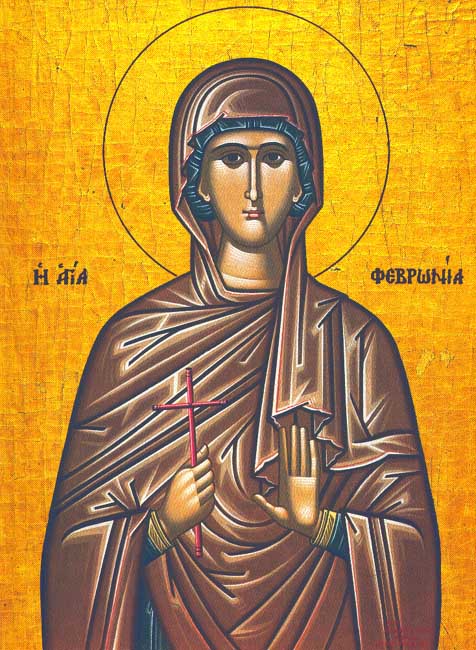The Holy Venerable Martyr Febronia
Febronia
was the daughter of Prosphorus, a senator from Rome. In order to
avoid marriage with a mortal man, Febronia betrothed herself to
Christ and was tonsured a nun in the east, in the country of Assyria,
in a convent where her aunt Bryaena was abbess. Lysimachus, the son
of a nobleman, desired to wed Febronia but since Emperor Diocletian
suspected him to be a secret Christian, he sent Lysimachus to the
east with his uncle Silenus to apprehend and kill Christians. Silenus
was as cruel as a beast and exterminated Christians everywhere
without mercy. Lysimachus, on the contrary, spared the Christians
wherever he could and hid them from his beast-like uncle. Making
Palmyra a wasteland of Christians, Silenus came to the town of
Nisibis close to which was a convent with fifty ascetics among whom
was Febronia. Even though she was only twenty years old, Febronia was
respected in the convent and in the town because of her great
meekness, wisdom and restraint. In this convent the rule of the
former abbess Blessed Platonida was adhered to in that every Friday
be spent only in prayer and the reading of the sacred books without
any other type of work. Bryaena had designated Febronia to read the
sacred books to the sisters hidden behind a curtain so that no one
would be distracted and captivated by the beauty of her face. Hearing
about Febronia, Silenus ordered that Febronia be brought to him. But,
when the holy virgin refused to deny Christ and to agree to enter
into marriage with a mortal man, Silenus ordered her to be whipped,
and after that to knock out her teeth, cut off her hands, breasts
then legs and finally to slay her with a sword. However, a horrible
punishment from God befell the torturer the same day. A rage entered
into him and he was overcome by a deadly horror. In this horror he
struck his head against a marble pillar and fell dead. Lysimachus
ordered that Febronia's body be gathered and brought to the convent
where it was honorably buried and he, with many other soldiers, were
baptized. Many healings have occurred from the relics of St. Febronia
and she appeared on the day of her feast and stood in her usual place
among the sisters and all the sisters looked upon her with fear and
rejoicing. St. Febronia suffered and took up habitation in eternal
blessedness in the year 310 A.D. In the year 363 A.D., her relics
were translated to Constantinople.
Respectably
Taken From the:
"The
Prologue of Ohrid"
by
St. Nikolai of Zica, Serbia(Velimirovic)

No comments:
Post a Comment